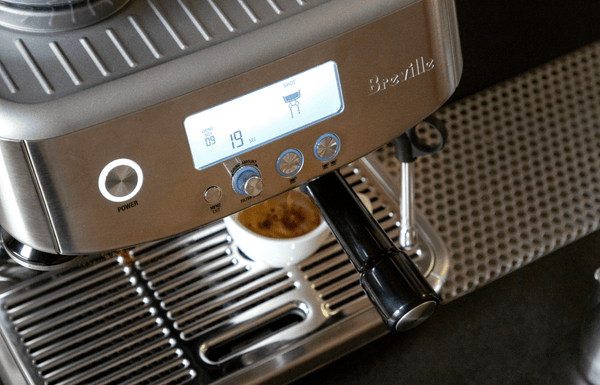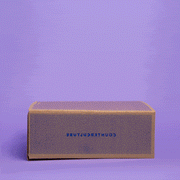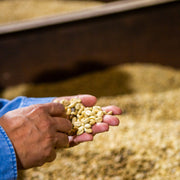The history of the machine that gives us this bean-drink-process is fascinating, and worth knowing a little about before you dive into actually making espresso.
Why Espresso?

For historical context, we need to go back to Italy at the turn of the twentieth century. At the time, Italians had fallen in love with Arabic coffee—what you may now know as Turkish or Greek coffee: finely ground coffee combined with water and boiled in a pot called an ibrik over an open flame or in heated sand. The result is viscous and strong!
At the same time, Europe was experiencing huge urban migrations as a consequence of the Industrial Revolution. While more and more Italians moved out of the countryside to work in factories, they still needed their coffee break. But the style of coffee making at the time took a lot of time! It was at least five minutes to boil and brew a cup, followed by cool-off time so as not to burn one’s mouth.
In stepped some innovators.

In 1901, the first patented espresso machine was invented by Luigi Bezzera, who almost immediately sold his patent to Desiderio Pavoni (whose name is synonymous with Italian-built espresso machines to this day). This first machine was an instant classic—maybe you’ve even seen one on the bar at a fancy Italian restaurant. It used an open flame under a boiler to heat the water, and then dispensed water at a near boil through the coffee in a large “proto-portafilter.” The result was a close approximation to Turkish coffee, but it could be produced in a minute or less. More coffees, made faster!
This first espresso didn’t look exactly like what high-end cafes make today, or even what home baristas are producing on their tiny countertop machines. Turning out, at best, 1.5 bars of pressure, Bezzera’s machine didn’t produce nearly enough pressure to create espresso’s characteristic crema, or foam, on the surface of the drink. Nevertheless, it made coffee fast, and that alone was a huge advantage for cafes.
Espresso Machine Innovation
The original espresso machine manufacturers weren’t particularly focused on making coffee equipment—they were mostly just boilermakers. Unlike today, where every machine that comes out seems to need some new bell or whistle (actually, if your machine is whistling, you should definitely get that checked out), the first espresso machines weren’t innovated quickly or very often.

Thus, the first big innovation in espresso technology didn’t arrive until 1946, when Achille Gaggia introduced the spring lever. In these machines, water was still brought to a full boil, but when the lever was pulled down, a spring was compressed and a valve opened to allow water into the group. Water would cool slightly in this transition, which is better for brewing. Then the lever was released and the water was pushed with the mechanical energy made by the spring releasing through the coffee. Pressure spiked up to 14 bar, and then slowly decreased as the spring came back to its original shape.
This increased pressure did two things: First, it sped up the brewing process. Instead of a full minute, shot could be brewed in 30-45 seconds. Second, the higher pressure (which now exceeded 4 bar) produced crema! A sign of fresh espresso and an intoxicating aroma, crema is for many the best part of espresso. Thank you, Achille Gaggia!
Technology And Design

Lever machines were a wonderful innovation that improved process and quality, but making a single coffee took a lot of physical effort, and consistency was difficult to achieve. In 1961, Ernesto Valente invented the E61, and the first modern-looking espresso machine was born. Aside from establishing a classic look, its electric pump represented a substantial jump in technology. Instead of physically pulling on a lever, pressure could now be consistently set and executed by way of a motorized pump. Want 5 bars of pressure? 6? 12? You can set it wherever you want! (The standard is 9 bar. There are several explanations for why this is the number the industry landed on, but none have been confirmed. Nine was my high school baseball number, so I’ll just say it’s fate.)
Temperature

Finally, in 1970, the Italian company La Marzocco made some innovations that got temperature under control: dual boilers, PID controllers, and saturated groups (oh my!).
Instead of just one boiler being used to heat water for brewing and steaming milk, now there was a dedicated boiler for each process. This allowed baristas to set separate temperatures for both at the same time and get optimal results. Using the PID (or “Proportional Integral Derivative” control), a circuit with an algorithm is dedicated to maintaining a constant temperature. Saturated groups keep the metal around the portafilter hot, keeping temperature steady as water leaves the boiler and travels up to the group to brew coffee.
Gotta Grind
Making the perfect espresso involves one more vital piece of equipment: the espresso grinder. But why? What’s different about an espresso grinder, compared to one designed for brewing filtered coffee?

The biggest difference is that an espresso grinder has much finer calibration. Getting the grind right for espresso can be a finicky thing, and if the smallest adjustment available is in fact a relatively big one, getting your recipe just right can be next to impossible. Additionally, most home-use grinders that claim to be able to make espresso and filter coffee are likely cheating a little one way or the other on their calibration. In my experience, if a grinder is good at making one kind of coffee, they are much less likely to be good at making the other. The calibration is almost always too fine or too coarse for espresso, and the range of grinds available isn’t enough to make both brewing methods possible.
Espresso grinders are also made with hoppers on top that are meant to hold coffee. When you grind for filter coffee, ideally you weigh out each dose precisely, and the coffee you put into the hopper will all come out the bottom. With espresso, because you’re often making coffee after coffee (at least in a cafe environment), you need to have the coffee ready to grind on demand. There are various technologies that time the dose or even weigh it for optimal precision, but, with very few exceptions, you wouldn’t want to weigh out each and every dose of espresso before you grind it.
If you have an espresso grinder at home and you’re using the hopper as intended, you’ll want to periodically clean it out. Empty the coffee and give the hopper a dry wipe. If you want to use water or any other wet cleaning solution, remove the hopper before you clean it, and let it air dry overnight. If moisture gets into the grinding chamber, the coffee coming out is going to get muddy and can jam up the machine, so be careful with water around your grinders.

And if you’re interested in getting some virtual or in-person training with one of our educators, check out the classes on Eventbrite. There are learning opportunities for all!






